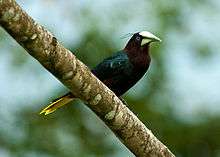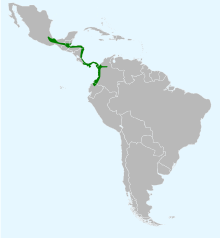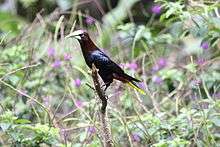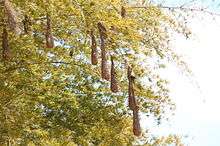Chestnut-headed oropendola
The chestnut-headed oropendola (Psarocolius wagleri) is a New World tropical icterid bird. The scientific name of the species commemorates Johann Georg Wagler, who established Psarocolius, the oropendola genus.
| Chestnut-headed oropendola | |
|---|---|
 | |
| At Cordillera de Talamanca, Costa Rica | |
| Scientific classification | |
| Kingdom: | Animalia |
| Phylum: | Chordata |
| Class: | Aves |
| Order: | Passeriformes |
| Family: | Icteridae |
| Genus: | Psarocolius |
| Species: | P. wagleri |
| Binomial name | |
| Psarocolius wagleri (J E Gray, 1845) | |
 | |
| Range of P. wagleri | |
| Synonyms | |
|
Psarocolius waglerii (lapsus) | |
Description
The male is 35 cm (14 in) long and weighs 225 g (7.9 oz); the smaller female is 28 cm (11 in) long and weighs 125 g (4.4 oz). The wings are very long. Adult males are mainly black with a chestnut head and rump and a tail which is bright yellow apart from two dark central feathers. The iris is blue and the long bill is whitish. Females are similar, but smaller and duller than males. Young birds are duller than adults and have brown eyes. The populations south of an area around the border of Honduras and Nicaragua are sometimes separated as a subspecies P. w. ridgwayi, but the separation of this form has been questioned.
The distinctive songs of the male include a gurgle followed by a crash guu-guu-PHRRRRTTT. Both sexes have loud chek and chuk calls.

Range and ecology
It is a resident breeder in the Caribbean coastal lowlands from southern Mexico to central Costa Rica, both slopes of southern Costa Rica and Panama, and the Pacific lowlands of Colombia and north-eastern Ecuador. Though it usually stays below 1,000 m (3,300 ft) ASL, it has also been recorded as much as 1,300 m (4,300 ft) ASL, for example in the Serranía de las Quinchas of Colombia. It may in fact be more common at such high altitudes at particular times or in particular places, but its altitudinal movements are insufficiently understood.[2] The species is common across its large range and not considered threatened by the IUCN.[1]
The chestnut-headed oropendola inhabits forest canopy, edges and old plantations. It is a quite common bird in parts of its range, seen in small flocks foraging in trees for large insects, fruit and berries.

It is a colonial breeder which builds a hanging woven nest of fibres and vines, 60–100 cm (24–39 in) long, high in a tree. There may be 40–50 females and only 4–5 males in a colony. The female lays two dark-marked pale blue eggs which hatch in 17 days and fledge in 30. Botflies (Oestridae) are the main cause of nestling mortality, but brood parasitism by giant cowbirds (Molothrus oryzivorus) also occurs, and the young cowbirds will feed on the fly larvae.
Footnotes
- BirdLife International (2012). "Psarocolius wagleri". IUCN Red List of Threatened Species. 2012. Retrieved 26 November 2013.CS1 maint: ref=harv (link)
- Laverde-R., Oscar; Stiles, F. Gary; Múnera-R., Claudia (2005). "Nuevos registros e inventario de la avifauna de la Serranía de las Quinchas, un área importante para la conservación de las aves (AICA) en Colombia" [New records and updated inventory of the avifauna of the Serranía de las Quinchas, an important bird area (IBA) in Colombia] (PDF). Caldasia (in Spanish and English). 27 (2): 247–265.
References
- Jaramillo, Alvaro; Burke, Peter (1999). New World Blackbirds. London: Christopher Helm. ISBN 0-7136-4333-1.
- Stiles, F. Gary; Skutch, Alexander F. (1989). A Guide to the Birds of Costa Rica. Comstock Publishing Associates. ISBN 0-8014-9600-4.
External links
| Wikimedia Commons has media related to Psarocolius wagleri. |
| Wikispecies has information related to Psarocolius wagleri |
- "Chestnut-headed oropendola media". Internet Bird Collection.
- Chestnut-headed oropendola photo gallery at VIREO (Drexel University)
- Chestnut-headed oropendola species account at Neotropical Birds (Cornell Lab of Ornithology)
- Audio recordings of Chestnut-headed oropendola on Xeno-canto.
